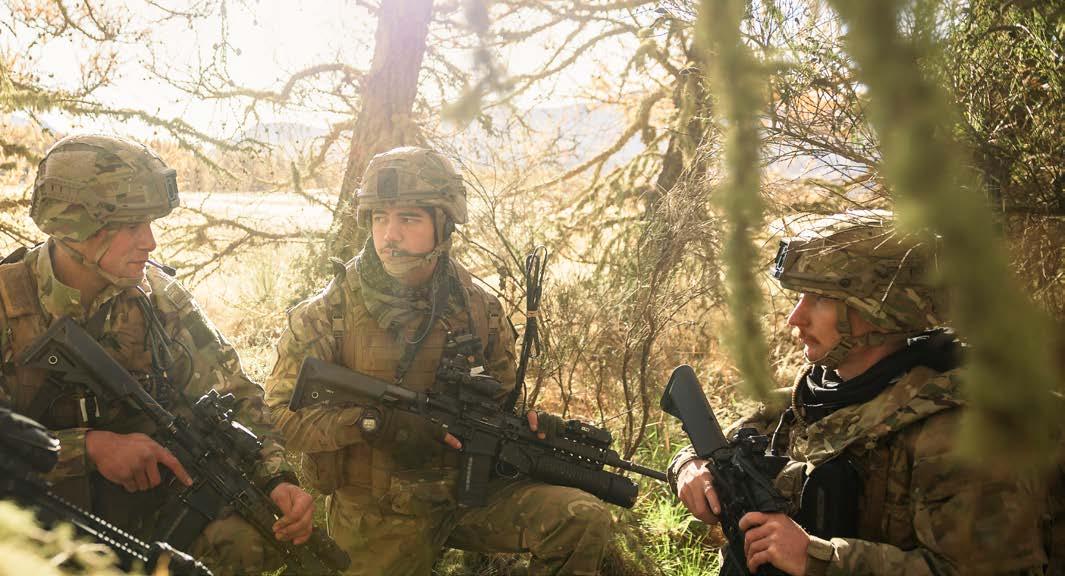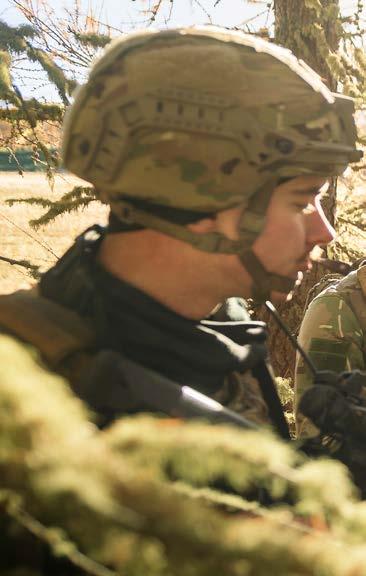
3 minute read
ARMY CAPSTONE ORDERS
Army General Staff continues to work through the Capstone documents to make our purpose clear and to deliver the Army Plan.
Frequent updates have been provided to share where we are at with decisions and our steps towards our goal of sustained operational readiness. This provides clarity on how we will communicate our outputs, and manage tempo, create safe training, and relieve the staff burden on our commanders down. The plan is another step forward. Please know there is more work to be done to get us to where we need to be. Thank you for your patience.
Advertisement
The Command Statement has three key annexes which are currently under consultation. These are:
The purpose of this document is to define the Order of Battle used by the NZ Army for operational purposes. This ORBAT also informs capability, training, people and force generation planning. The Army has two universal operational ORBATs, one used by each Army Component Command. The Motorised Infantry Battle Group (MIBG) and the Special Operations Task Group (SOTG).
The purpose of this document is provide orders on the approved doctrinal publications that are to be used by the New Zealand Army for the conduct of land warfare. Doctrine is the primary professional body of work used by military professionals. It provides principles and guidance to plan, integrate and execute military operations.
The first document of the Capstones that was released was the Army Command Statement (Nov 22). AGS is in the process of enacting the staff work and processes that confirmed the value of five major organisational refinements:
1. Realignment to Australian Doctrine;
2. Reconstitution of the Army Training System;
3. Reconstitution of Capstone Orders;
4. Doctrinal alignment of Army’s primary outputs the MIBG and SOTG; and
5. Transition to a deliberate Readiness Model.
What does this mean for you?
Look out for the NZ Army Plan as it will be the central document to order, manage and guide Army efforts. It will have:
The Acceptable Enduring Condition – how the Army will be organised, trained, equipped, scaled and supported in order to sustain operational readiness as directed by the Government
• Four lines of operation: Capability; Training; People; and Force Generation (of the MIBG, SOTG, Land Support and Army Reserves)
A Land Support Plan to enable, support and sustain Army Force Generation
A Reserve Plan to coordinate the operational and training integration of the Army Reserve

• The transition to a Readiness Model, as we achieve our regeneration milestones.
Next steps
The purpose of this document is to make clear our requirement for a culture of professional excellence where we the soldiers, officers and civilians of Ngāti Tūmatauenga are empowered to act and prepared to win in combat on the land. A culture where our people are respected, included, and valued members of the Profession of Arms.
• Ongoing engagement with the Defence Policy Review and the Defence Capability Plan
• Increased cooperation under Plan ANZAC will be initiated with AGS working groups, and reciprocal visits
On Talisman Sabre 2023 (TS23), the deployed force elements, the G7 and elements from 1BDE will analyse the employment of selected doctrine. The G7 will then report back with appropriate observations on doctrinal alignment and impacts across Army’s lines of operations
The observations from TS23, and broader doctrinal alignment, will be matched to Government policy direction in the Defence Policy and Strategy Statement
• These observations and direction will, after completion of the current Army force design project, allow DCA and AGS to start analysis on the next iteration of Army’s force design – matched to our doctrinal alignment
• This analysis will, like last time, include consultation with the chain of command and Regimental Colonels.
Army Capstone Orders
CREATING THE STRUCTURES TO COMMAND, CONTROL AND MANAGE ARMY AS A SYSTEM
ARMY COMMAND STATEMENT
Sustained Operational Readiness of Army's multi role combat forces
ARMY ORBAT
MIBG and SOTG structure for capability, training and readiness
ARMY DOCTRINE
List of AS integrated doctrine, and independent addenda
ARMY PLAN
ARMY CULTURE
Captures the independent culture of Ngāti Tūmatauenga
To be integrated and independently capable, Army must sustain operational readiness of Land and Special Operations military response options, by training them to world class standards; by equipping them with credible capabilities; by recruiting high quality New Zealanders; and then force generating Army’s Motorised Infantry Battle Group and Special Operations Task Group platforms.
CAPABILITY PLAN
TRAINING PLAN
ARMY FORCE GENERATION ORDERS
PEOPLE PLAN
Army Force Generation (OE2) requires that the Army is organised, trained and equipped for MIBG and SOTG combat (OE5.1), then sustained at readiness for most likely operations (OE5.2), and contingencies (OE4)
ARMY OPERATING SYSTEM
The Army Operating System takes Army Command direction and delivers Army Plans and Army Force Generation Orders, to sustain the operational readiness of Army's operational outputs – its Motorised Infantry Battle Group, Special Operations Task Group, and their subordinate Military Response Options.





